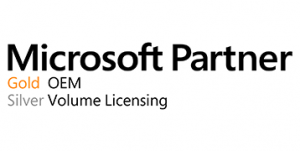
One thing is clear no matter the size of your business: Technology has impacted our culture in such a way that what has made your business successful in the past won’t necessarily guarantee future success. Customers expect to interact with brands in the same highly digital ways they do with their family and friends. Employees have new expectations when it comes to where and how they get work done. Innovation is happening faster than ever before.
The key to keeping up for small businesses? Technology. Thanks to the cloud, IT that was formerly reserved for big companies with big budgets is now available to businesses of all sizes. And because of this, there has never been a better time for SMBs to embrace technologies that change the way they do business, connect with customers, drive profits and innovate. We call this digital transformation. For many businesses, the word “transformation” probably feels intimidating, overwhelming and perhaps even unreachable. The most common myth I hear from many business owners is that transformation equals business disruption and change management challenges. But the reality is that technology can enable small businesses to achieve what they may not have thought possible – things like uncovering new revenue streams through data insights, or automating routine business processes to get time back in their day.
Put simply, there’s no better time for SMBs to embrace digital transformation. And Complete IT Systems and Microsoft can assist you on this journey.
Trend 1: The way people want to work is changing
Business no longer happens in one place; The concept of the workday being 9 to 5 and the office being a place with four walls is no longer the norm. In fact, nine out of 10 employees spend at least 20 percent of their time away from their primary workplace. Yet things like real-time communication, face-to-face interactions and leveraging collective knowledge are still critical to employee productivity. So, it’s up to business owners today to re-imagine how to provide these experiences in this new world of work.
The Autry Museum recognised this shift in how work gets done and was quick to adopt technology to help its employees stay connected despite being dispersed between three sites across the Los Angeles area. The museum transitioned to Office 365 to enable its employees to be more productive while away from their desks – a critical capability given that the majority of the staff spends most of their day on the museum floor. Now, employees can quickly respond to emails. schedule meetings and manage their calendars from wherever they are. This functionality has been especially beneficial when managing the many events that take place at the museum – staff can easily check calendars for venue availability, manage rentals and share documents with clients in real time. This freedom to work in whatever way is best for the individual, while remaining productive and connected with the business and providing the best guest service possible, is especially crucial.
Trend 2: Customer expectations are changing
The ability to acquire and retain customers is perhaps the single most important factor for small business success. Without customers, nothing else matters, which is why more than half of all businesses say their success depends on their ability to be highly responsive to customers’ specific needs. We know that 86% of customers are willing to pay more for a better customer experience, but for a small business, this can be a daunting expectation given that resources are tight and staff time is even tighter. While good customer service will always require a personal touch, technology has helped small businesses consolidate customer information, automate routine processes and act faster on new opportunities than ever before.
A customer relationship management (CRM) solution is quickly moving from a “nice to have” to a “must have” for businesses to provide the level of service customers expect. These solutions enable businesses to track customer information such as purchase history, follow-up actions, preferences and more to build loyalty among current customers and uncover new revenue opportunities. Many CRM systems integrate with a business’s existing technology to provide a seamless experience. For example, Outlook Customer Manager is a simple but powerful new feature available to Office 365 users that offers businesses a complete view of interactions with individual customers, helps track tasks and deals in progress and sends reminders for important meetings and milestones. And, as business needs grow, companies can move from Outlook Customer Manager to Dynamics 365 to take advantage of enhanced customer information, insights into process efficiency and consistency and deeper financial insights.
Trend 3: Technology can do the work for you
In many small businesses, IT management isn’t afforded a full headcount. Often, it’s either the business owner or the employee who knows the most about technology who carries the burden. The cloud takes the responsibility of technology maintenance and updates off the business and puts it on the cloud service provider – freeing up business owners and employees to focus on other revenue-generating tasks.
Today’s cloud platforms and applications empower small businesses to reduce the cost and complexity of their IT investments while also boosting compliance and security with automatic updates that give them peace of mind. Fifty-two percent of businesses worldwide say the cloud makes their IT staff more productive, and data from Boston Consulting Group shows that businesses that leverage cloud technology improve their efficiency and productivity.
Trend 4: Data is taking the risk out of owning a business
Small business owners invest their blood, sweat, tears and – in many cases – their entire worth into their business. So, making decisions on behalf of the business based on assumptions or gut feelings isn’t enough. Data is a small business’s secret weapon in keeping pace with the competition and keeping customers. To understand how to grow and evolve their organization, a business owner should lean on data to help them anticipate the next big thing – whether that be an untapped industry opportunity or emerging customer need.
Most businesses today have a wealth of data on hand that will provide insight into exactly these things, but many don’t know how to stitch it all together to uncover the opportunities that will propel their business forward. For instance, customer purchase history data can help businesses better identify when they’ll need to stock up on certain products. Web traffic patterns give insight into the best times to target customers with ads and offers. Data is key in unlocking insights from the data businesses already have at their fingertips, and takes the guesswork out of running a company.
Technology built to work for you
The key to good technology is that it works for you, and not the other way around. Microsoft cloud solutions bring together the best platforms like Windows 10 with best-in-class applications like Office 365, Skype, OneDrive, Dynamics 365 and others to make work easier for businesses and help them better compete and grow. With Microsoft’s cloud solutions, small businesses now have access to the same calibre of technology that their enterprise counterparts use, removing the long-standing barriers that used to give big business a leg up and empowering small businesses to drive forward industry transformation.
Want to find out more?
As Microsoft Gold Partners, Complete IT Systems can offer you expert advice on the solutions and how they could be effectively deployed in your business.
To find out more please call us on 01274 396 213 or use our contact form and we’ll arrange a good time to call you back. This handy infographic from Microsoft also outlines succinctly how its solutions can assist your organisation’s GDPR needs.






